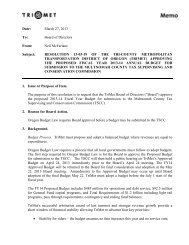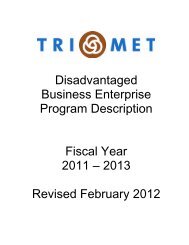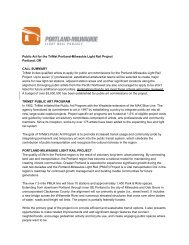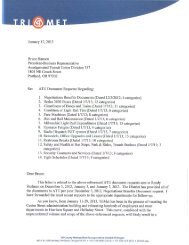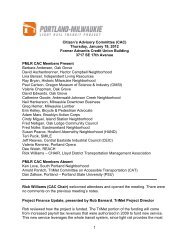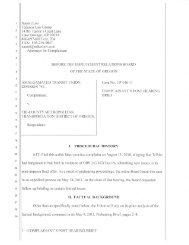2012 analysis - TriMet News
2012 analysis - TriMet News
2012 analysis - TriMet News
Create successful ePaper yourself
Turn your PDF publications into a flip-book with our unique Google optimized e-Paper software.
TRANSMITTALDate: April 20, <strong>2012</strong>To: Jonathan Hunt, Amalgamated Transit Union Local Chapter 757Jan Campbell, Committee for Accessible TransportationOther Interested PartiesFrom:Cc:Subject:Neil McFarlane, <strong>TriMet</strong> General Manager<strong>TriMet</strong> Board of DirectorsBringing LIFT in-house AnalysisAs <strong>TriMet</strong> grapples with a $12-17 million dollar budget shortfall for Fiscal Year 2013, ithas been suggested that <strong>TriMet</strong> could save $7.5 million a year to bring the operation ofour LIFT paratransit services in-house.In reviewing the Lauka & Associates report (Feb 2008), we could find no evidence ofsuch savings in their <strong>analysis</strong>. Because <strong>TriMet</strong> is always seeking ways to reduce costs, Iinstructed <strong>TriMet</strong> staff to undertake a detailed <strong>analysis</strong> using current data andassumptions since LIFT ridership has increased more than 10% since the periodevaluated by Lauka. This <strong>analysis</strong> is summarized in the attached memo. As you will see,there are no long-term savings that result from bringing LIFT service in-house. Stafffound that bringing LIFT paratransit service in-house would in fact, cost <strong>TriMet</strong> more inthe long-term putting even greater financial burden on the agency’s budget.With that information in hand, I have concluded that it is not in the best interest of <strong>TriMet</strong>and our customers to bring this service in-house. Because of precedents of labor law,any potential short-term benefits are quickly outweighed by the long-term costsassociated with integrating the LIFT union workforce into the <strong>TriMet</strong> union workforce.Please see the attached report that summarizes both the Lauka & Associates findingsfrom 2008 and the findings from <strong>TriMet</strong>’s internal <strong>analysis</strong> as of April <strong>2012</strong>. You will alsofind, in detail, documentation for <strong>TriMet</strong>’s internal <strong>analysis</strong>.We are asking for the ATU, CAT and other interested parties to please review thedocuments and submit any comments to me regarding this report by May 8, <strong>2012</strong>. Pleasebe as detailed as possible when commenting so that we are able to accuratelyunderstand your concerns and provide further <strong>analysis</strong> of your concerns. If no significantanalytical flaws are found with regard to <strong>TriMet</strong>’s updated <strong>analysis</strong>, I will present thisreport, together with comments received, at an upcoming Board meeting.
<strong>TriMet</strong> LIFT Paratransit ServiceAnalysis Overview________________________________________________Question:Can <strong>TriMet</strong>’s LIFT paratransit service be brought in-house in acost-effective manner to save the agency money?Background<strong>TriMet</strong> provides LIFT service through partnerships with private sector contractorsselected through a competitive bidding process. Contract awards are madebased on best value criteria, which specifically evaluate highest quality serviceand most favorable pricing for <strong>TriMet</strong>. This has been the practice since 1980.Bringing it in-house would represent a significant change in cost andmanagement structure.Current LIFT contractors are:o First Transit – LIFT Transportation (operators, management andsupport staff)o First Transit – LIFT Central Dispatch (reservationists, schedulers, customerservice specialists, dispatchers, management and support staff).o Penske – LIFT Maintenance (mechanics, management and supportstaff)<strong>TriMet</strong> requires LIFT contractors to provide highly qualified staff for theLIFT operation and has established specific performance criteria, whichinclude financial penalties for non-performance. <strong>TriMet</strong> supplies facilities,revenue vehicles, and equipment for the LIFT Program.<strong>TriMet</strong> staff handles program management, contractor oversight,administration, and eligibility of customers for LIFT service.Below we summarize the Lauka findings in 2008 and provide a current <strong>analysis</strong>which compares costs of contracted LIFT service with costs that <strong>TriMet</strong> wouldincur if <strong>TriMet</strong> employees provided the service.Lauka & Associates Review – February 2008<strong>TriMet</strong> and the Amalgamated Transit Union (ATU) commissioned a study thatwas performed by Lauka and Associates.The Lauka and Associates report demonstrated that <strong>TriMet</strong> would incursignificant cost increases for wages and benefits if LIFT operators andtransportation support staff were to become <strong>TriMet</strong> employees. As shown onpage 1 of the Lauka report, the additional cost of bringing paratransit services inhousein 2004 was $3.8 million. The Lauka report explicitly shows that healthinsurance for in-house employees would be $2.2 million higher per year (more<strong>TriMet</strong> LIFT Analysis 1 April 20, <strong>2012</strong>
than 5X the cost of contracted employee health insurance), and pension costswould be $2 million higher per year (14x higher than contracted employeeretirement costs).The Lauka report also calculated the cost of bringing paratransit services inhouseassuming contractor wages and benefits remained unchanged (and didnot increase to <strong>TriMet</strong> levels). As discussed in detail below, this is an unrealisticlong-term assumption as incoming employees who perform work similar toexisting employees will ultimately become part of the existing bargaining unit.Findings:1. The Lauka and Associates report demonstrates that <strong>TriMet</strong> would incur significantcost increases for wages and benefits if LIFT operators and transportation supportstaff were to become <strong>TriMet</strong> employees.2. Retiree and health care benefits would be a major component of the expected$3.8 million in additional expenses. According to the Lauka and Associates<strong>analysis</strong>, health care costs alone would increase by more than $2 million per yearif LIFT service were brought into <strong>TriMet</strong> under the current contract.<strong>TriMet</strong> LIFT Staff Review – April <strong>2012</strong><strong>TriMet</strong> LIFT staff, in conjunction with the Finance & Administration division, provided acomparative <strong>analysis</strong> of Fy11 LIFT contractor costs vs. in-house costs using current dataabout direct and indirect costs, service levels and wages. The full <strong>analysis</strong> is attached.The largest component of LIFT contract costs, including Transportation, Central Dispatch,and Maintenance is personnel. Consistent with the Lauka findings in 2008, wages andbenefits would be significantly more expensive should <strong>TriMet</strong> cancel the LIFT contractsand bring all LIFT personnel in-house as <strong>TriMet</strong> employees. All operators, mechanics,and most Central Dispatch and Transportation indirect staff would receive union wagesand benefits.<strong>TriMet</strong> wage and benefit costs for the LIFT Program would be expected toincrease by more than $24 million per year if LIFT employees were brought inhouseat current wage and benefit levels. This increase consists of the following:o $24 million per year higher costs of labor costs, including wages, benefits,training, etc. for Operators, Central Dispatch, and Maintenance employees.o Administrative, profit, overhead and other operational costs are very closein either scenario: estimated savings are approximately $200,000 per yearby bringing LIFT in-house.If LIFT personnel were brought in-house at the existing wage rates of LIFTcontractors, but with <strong>TriMet</strong> benefits, the expected annual increase in costs wouldbe more than $16 million rather than $24 million.<strong>TriMet</strong> LIFT Analysis 2 April 20, <strong>2012</strong>
While the <strong>analysis</strong> shows that non-labor costs would be slightly lower under inhousescenarios, potential savings in these areas are less than $1 million, so areovershadowed by expected labor cost increases.It has been suggested that if <strong>TriMet</strong> were to bring LIFT service in-house, savings couldresult from reductions in management and indirect staffing currently included in the LIFTcontract. We believe this is an unrealistic assumption. The <strong>TriMet</strong> <strong>analysis</strong> assumes thatthe contracted LIFT Program staffing levels for management, supervisory and supportpositions would be maintained at current levels, because it is not realistic to assume thatcurrent <strong>TriMet</strong> management and support staff could assume oversight and managementof more than 450 additional employees at three different locations.Even if this were operationally feasible, potential savings due to management reductionsare insignificant compared to expected wage and/or benefit increases resulting frombringing LIFT program personnel to the <strong>TriMet</strong> wage and benefit levels.Findings: <strong>TriMet</strong>’s updated cost <strong>analysis</strong> demonstrates that <strong>TriMet</strong> would incur $16 to $24million additional costs per year by bringing LIFT services in house.Labor Contract ConsiderationsIntegration of Union EmployeesIt has been suggested that current LIFT contract employees could be brought into <strong>TriMet</strong>at their current wage and benefit levels. While top operator wages for LIFT drivers aresimilar to the top bus operator wages at <strong>TriMet</strong>, the wages of other contract workers arelower than <strong>TriMet</strong> wages and benefit levels of <strong>TriMet</strong> ATU employees vs. LIFT contractemployees are significantly different.There is significant National Labor Relations Board (NLRB) precedent regarding bringinga unionized workforce into an established unionized work force, but not as much ERBprecedent. We would expect that the ERB would look to NLRB case law in decidingbargaining obligations were we to bring LIFT Services in-house. Based on how mattersmight be handled under NLRB case law, even if we were successful in negotiating a“freeze” in LIFT wages and benefits with the ATU, it would only be good for a short time,and would produce small, if any, savings. In the end, however, there would be pressureto merge the two work groups, which <strong>TriMet</strong> could not prevent. Once merged, historyshows that the terms and conditions of the dominant work unit very quickly are applied tothe entire merged workforce. The structure and work rules of the fixed route operators willquickly lead to financial inefficiencies if applied to our scheduled door to door service forLIFT clients. In addition, the higher costs would negatively impact <strong>TriMet</strong>’s long-termfinancial sustainability by enlarging the group of employees who receive non-marketbased benefits. It is shortsighted and not in the public interest to exchange modest shorttermsavings for significantly higher long-term costs.<strong>TriMet</strong> LIFT Analysis 3 April 20, <strong>2012</strong>
Findings: LIFT employees will ultimately be brought into the larger <strong>TriMet</strong> ATU group withsimilar wages, benefits and retiree obligations -negating any short-term savings. Even at the outset as a separate unit, the LIFT Services unit would be strikeprohibited and subject to interest arbitration.Additional Impacts: contracted versus in-houseThe private contractor model also protects our most vulnerable population by permittingthe prompt disqualification of an operator who demonstrates poor judgment, whether onor off the job. The <strong>TriMet</strong> labor contract requires extensive review of such conduct and adirect connection to the job duties. Moreover, the arbitration process reviewing disciplinefor public employees can return a poorly performing employee to the workplace whileignoring the reality of the needs of the public and leaving the public body withoutrecourse.ConclusionThe Lauka & Associates 2008 report, as well as the more recent <strong>analysis</strong> by<strong>TriMet</strong>’s LIFT staff, confirm that <strong>TriMet</strong> would incur significant increases towage and benefit costs if LIFT operators and staff were to become <strong>TriMet</strong>employees.There is the possibility we could negotiate short-term savings by bringingLIFT Services in-house but those savings would be quickly overwhelmed asthe two bargaining units would be merged.Having LIFT employees brought under current <strong>TriMet</strong> union work rules couldaffect quality of service to a vulnerable population.<strong>TriMet</strong> LIFT Analysis 4 April 20, <strong>2012</strong>



